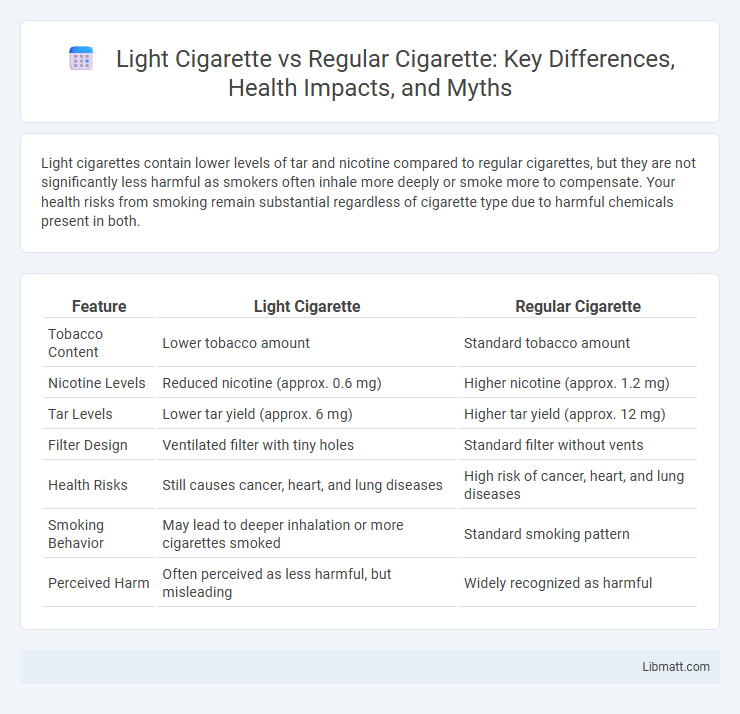Light cigarettes contain lower levels of tar and nicotine compared to regular cigarettes, but they are not significantly less harmful as smokers often inhale more deeply or smoke more to compensate. Your health risks from smoking remain substantial regardless of cigarette type due to harmful chemicals present in both.
Table of Comparison
| Feature | Light Cigarette | Regular Cigarette |
|---|---|---|
| Tobacco Content | Lower tobacco amount | Standard tobacco amount |
| Nicotine Levels | Reduced nicotine (approx. 0.6 mg) | Higher nicotine (approx. 1.2 mg) |
| Tar Levels | Lower tar yield (approx. 6 mg) | Higher tar yield (approx. 12 mg) |
| Filter Design | Ventilated filter with tiny holes | Standard filter without vents |
| Health Risks | Still causes cancer, heart, and lung diseases | High risk of cancer, heart, and lung diseases |
| Smoking Behavior | May lead to deeper inhalation or more cigarettes smoked | Standard smoking pattern |
| Perceived Harm | Often perceived as less harmful, but misleading | Widely recognized as harmful |
Introduction to Light vs. Regular Cigarettes
Light cigarettes contain lower levels of tar and nicotine compared to regular cigarettes, which are designed to provide a milder smoking experience. Despite marketed health claims, studies reveal that light cigarettes still pose significant health risks due to compensatory smoking behaviors. The differences in chemical content do not eliminate the dangers associated with tobacco use and exposure to harmful carcinogens.
What Defines a Light Cigarette?
A light cigarette is defined by its lower tar and nicotine levels compared to regular cigarettes, achieved through design features such as perforated filters that dilute smoke with air. These modifications aim to reduce harmful substance intake, but studies show smokers may inhale more deeply or consume more cigarettes to compensate, negating potential benefits. Understanding these differences can help you make informed decisions about smoking risks and health impacts.
Chemical Composition Differences
Light cigarettes contain lower levels of tar and nicotine compared to regular cigarettes, achieved through ventilation holes and altered tobacco blends. Despite these modifications, harmful substances such as carbon monoxide, formaldehyde, and carcinogens remain present in both types. You should understand that smoking light cigarettes does not significantly reduce health risks due to similar toxic chemical exposure.
Tar and Nicotine Levels Compared
Light cigarettes contain lower levels of tar and nicotine compared to regular cigarettes, but these reductions often do not significantly decrease health risks. Tar levels in light cigarettes typically range between 4-10 milligrams, whereas regular cigarettes can contain 12-20 milligrams or more. Your exposure to harmful substances remains substantial because smokers may inhale more deeply or smoke more frequently to compensate for the reduced nicotine, negating potential benefits of lower tar and nicotine levels.
Health Risks: Light vs. Regular Cigarettes
Light cigarettes contain lower tar and nicotine levels compared to regular cigarettes, but they still pose significant health risks, including lung cancer, heart disease, and respiratory problems. Smokers often compensate by inhaling more deeply or smoking more frequently, negating any potential reduction in harmful exposure. Studies show no substantial difference in health outcomes between light and regular cigarette smokers.
Common Myths about Light Cigarettes
Light cigarettes are often perceived as less harmful due to their reduced tar and nicotine levels, but studies show they deliver similar toxic chemicals as regular cigarettes because smokers tend to inhale more deeply or smoke more frequently. The "light" label is misleading, as manufacturers design ventilation holes to dilute smoke, but smokers inadvertently block these holes with their fingers or lips, negating the intended effect. Health organizations, including the CDC and WHO, warn that light cigarettes do not reduce risks of cancer, heart disease, or respiratory issues compared to regular cigarettes.
Marketing Strategies and Consumer Perceptions
Light cigarettes are marketed with claims of reduced tar and nicotine, appealing to health-conscious smokers seeking a perceived safer alternative. Marketing strategies emphasize sleek packaging and terms like "light," "mild," or "low-tar," influencing consumer perceptions of reduced harm despite scientific evidence showing similar health risks to regular cigarettes. Consumer perceptions are shaped by these marketing tactics, often leading to misconceptions about reduced toxicity and encouraging continued smoking behavior.
Regulatory Actions on Light Cigarettes
Regulatory actions on light cigarettes include the U.S. Food and Drug Administration's ban on misleading labeling such as "light," "low," and "mild" to prevent consumer deception about reduced harm. The Family Smoking Prevention and Tobacco Control Act of 2009 empowered the FDA to mandate warning labels and restrict marketing strategies that suggest light cigarettes are safer alternatives. Global regulatory bodies like the World Health Organization Framework Convention on Tobacco Control (WHO FCTC) also advocate for standardized packaging and banning of misleading descriptors to ensure consumers are accurately informed.
Smokers’ Experiences and Preferences
Smokers often perceive light cigarettes as less harsh and believe they produce fewer harmful effects, influencing preferences based on taste and throat irritation. However, scientific studies indicate that light cigarettes deliver similar levels of nicotine and toxins due to compensatory smoking behaviors, affecting user satisfaction. Preferences vary, with some smokers choosing light cigarettes for perceived health benefits despite comparable health risks to regular cigarettes.
Conclusion: Choosing Between Light and Regular Cigarettes
Choosing between light and regular cigarettes involves understanding the health risks associated with both, as light cigarettes do not significantly reduce exposure to harmful chemicals or the risk of smoking-related diseases. Nicotine intake and tar levels may be lower in light cigarettes, but compensatory smoking behaviors often negate these differences. Both types pose serious health hazards, making complete cessation the most effective choice for reducing smoking-related harm.
Light cigarette vs Regular cigarette Infographic

 libmatt.com
libmatt.com